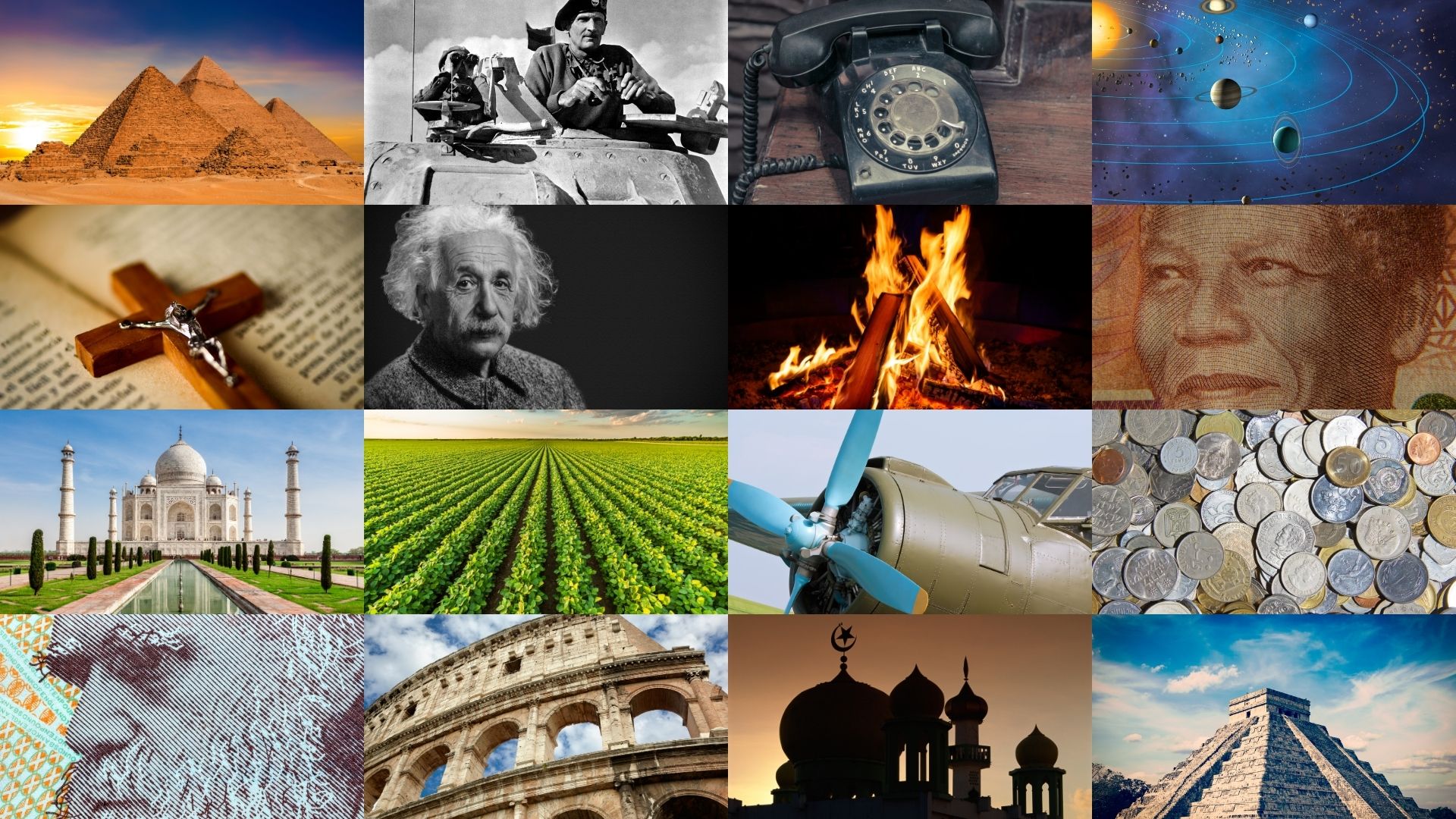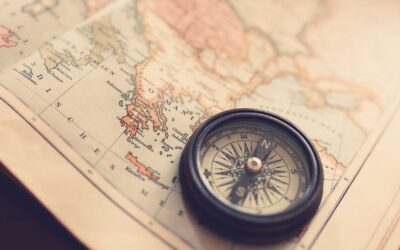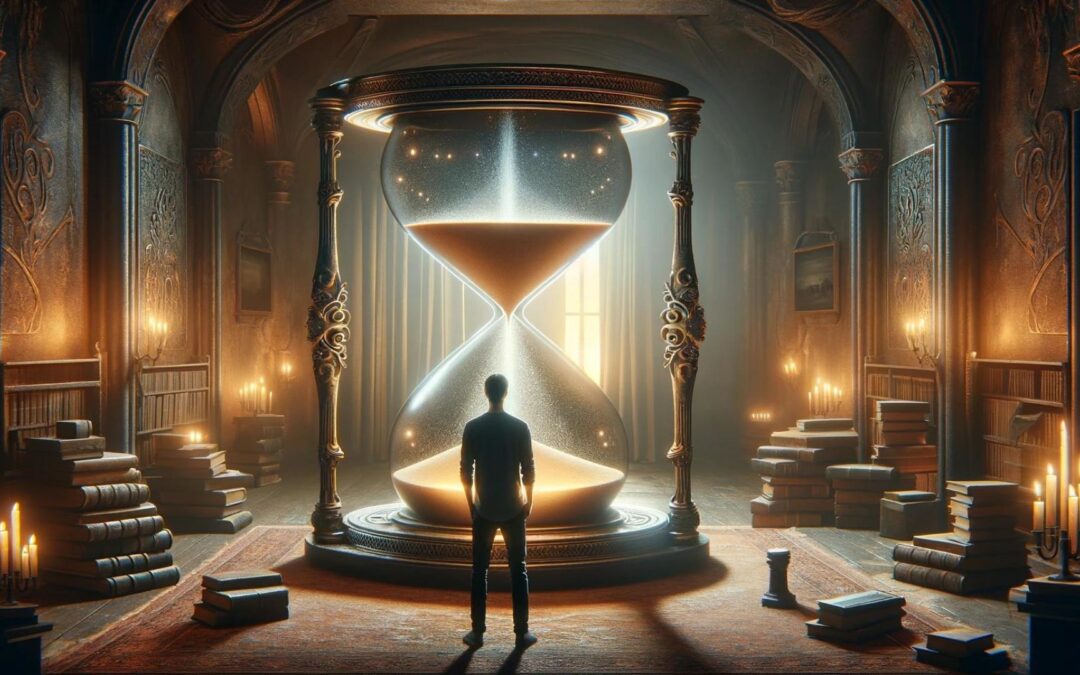Transcript
Disclaimer
I am using an automatic transcript service as it is not possible for me to do it on my own and I cannot afford human transcription at the moment. The service claims to have about 95% accuracy, which means there will still be some mistakes, so my apologies for having a less than perfect transcript, but I hope I can afford human transcription soon and I will solve this problem. However, the service is pretty good, and the transcript is almost perfect.
Transcript
Welcome to anew English plus podcast episode. In this episode, we will start a new series and this is 100 events that changed the world. In each episode of our 10 episodes from this series, we will talk about 10 events that changed the history of the world. So it’s very exciting to learn about those most important event.
[00:00:27] And that really changed the world, starting from the very first beginning of the man, discovers the fire and going all the way to our present date. So without further ado, let’s start. But first, let me tell you about the 10 events that we’re going to focus on, or we’re going to talk about today. The first event we’re going to talk about is how men discovers the use of fire.
[00:00:50] The second event is the emergence of the wise man or the homosapien. The third event is the invention of bows and arrows. The fourth event is the birth of agriculture. The fifth event is the first city. Chatel who you. The sixth event is when men makes the round wheel. In the seventh event, we will talk about the legendary pyramids of Giza.
[00:01:11] The eighth event is the code of Hammurabi. The ninth event is the creation of the first alphabet and the 10th event is the birth of the iron age. So we have a lot to cover. Let’s start. Let’s not waste any more time. Let’s start talking about. The first event. And that is when men discovers the use of fire.
[00:01:32] 1.4 million years ago, throughout millions of years, humans have evolved from a species largely at the mercy of nature to one that has managed and shaped its destiny. Learning to use fire was the key to that process. The two earliest known examples of the deliberate use of fire occurred in today’s Kenya and SWAT Kranz, South Africa dating back 1.4 and 1.3 million years ago.
[00:02:02] Respectively, when homo erectus started to migrate from Africa to Asia, they began to use naturally occurring fires in order to adapt to colder climates. Later around 7,000 BC homosapiens began making their own fires by using sticks or striking Flint against pyrite to set a spark to dry grass that would erupt into flame.
[00:02:28] These traditional methods are still used by traditional peoples in Africa and Australia, as well as campers around the world. Fire serves several functions for early man, the first and second being warmth and light, it also changed how humans eight since cooked flesh was easier to digest and prevented diseases ingested through raw meat.
[00:02:51] As time went on, fire became a military tool. Greek and Roman soldiers often use scorched earth tactics in war. Since then the uses of fire have varied widely. It is even used to shape or into metal creating the foundation for modern day steel plants, fire significant roles throughout human history is greatly represented through the flame as a symbol of both love and religion today.
[00:03:20] And now for the second event, the emergence of the wise man, about 120,000 years ago, the appearance of homo sapiens, anatomically modern humans was a long evolutionary process, probably descended from homo erectus who had evolved in Africa about 1.7 million years ago. Homo sapiens had larger brains were linguistically adept and capable of reflective thought.
[00:03:48] By the time homo sapiens, meaning wise, man emerged from Africa some 120,000 years ago. They were already much the same as today’s humans. During the course of 80,000 years, they traveled first to the middle East around 120,000 years ago, continued on to East Asia by about 50,000 years ago. And then to Europe, some 40,000 years ago.
[00:04:14] There they encountered Neanderthals classified, alternatively, as subspecies of homosapiens or a separate species descended from homo erectus whose brains were smaller in size, but may not have been as well developed for speech and social skills dependent on speech. They died out or were assimilated into the dominant populations of homosapiens some 32,000 years ago.
[00:04:39] And now for the third event, the invention of the bow and arrow around 15,000 BC, the development of bow and arrow was a momentous advancement that allowed early hunters, not only the safety of pursuing prey from afar, but also more accuracy and velocity than before. The exact date of its invention is elusive.
[00:05:01] Since the earliest examples may have been made of perishable materials, such as wood, the bow and arrow likely followed weaponry advances, like the spear thrower, the barbed harpoon, and the boomerang, the oldest specimens found are the home of guard bows dating to 9,000 BC discovered in a peat bog in Denmark.
[00:05:22] During the neolithic period, which dates from about 7,000 to 2000 BC, this early Misael was adapted to warfare in England. The remains of health Fords dating back 5,400 years. Show evidence of sustained archery attacks, including skeletons with embedded arrowheads neolithic cave paintings from Spain show hands of archers shooting at one another.
[00:05:47] Indeed archery would be used in warfare for millennials. And now for the fourth event that changed the history of the world. That’s the birth of agriculture that happened about 9,000 BC. The warmer climate that came with the end of the ice age, roughly 10,000 years ago, favored the transition from hunting and gathering to farming.
[00:06:08] At that time, the middle East suffered a dry spell limiting wild grain harvest. The areas communities began to supplement wild crops with their own plantings, storing the access to ensure their food supply. They also began to domesticate wild animals of the region, the practices of agriculture and animal domestication arose quickly in different parts of the world.
[00:06:32] Appearing in the Americas by 8,000 BC, Africa and India by 7,000 BC and East Asia and Europe by 6,000 BC. Barley we dries and oats. We’re the first to be systematically cultivated later, a thousand to 5,000 years ago, humans began planting root crops and legumes followed by fruit trees and leafy vegetables.
[00:06:56] Each area of the world grew regional foods though. Some spread via traders and migrants irrigation developed in Mesopotamia around 6,000 BC was critical to agricultural development, canals, reservoirs, and embankments allowed fresh water and silt deposits from the Tigris and Euphrates rivers to channel directly into fields.
[00:07:19] This increase made the soil more fertile, made farmers less dependent on rainfall and paved the way for the development of cities. And here we go to the fifth event that we want to talk about in today’s episode. And that is the first city . And that happened about 6,000 BC, perhaps not our idea of a metropolis.
[00:07:40] The settlement of in Anatolia modern day, Turkey is considered by many scholars to be the first city dating back about 9,000 years. meaning fork Mount in Turkish consists of two dirt mounds near the char Samba river. Walter fare service Jr. Was an American archeologists, described it as a community at the threshold of civilization.
[00:08:05] In its day, several thousand people lived in shuttle, who you dwelling in flat roofed, mud brick houses that were packed closely together and ascended the slopes of the mounds. Tuttle, who you citizens were, shepherds hunters, farmers, and gathers of wild plants from the nearby marches. They will have cloth main baskets and pottery and tent leather.
[00:08:29] They also traded obsidian, naturally occurring, volcanic glass. They gathered from volcanoes to the North East and crafted into knives and tools. It is clear that shuttle, who you had many of the trappings of urban life, including a barter economy, division of labor, social hierarchy, and private ownership of land.
[00:08:48] Brought to worldwide attention in 1961 by British archeologists, James Milad. Chatel who you continues to be excavated today. Its size and complexity are unparalleled. Many rooms include figurines, animal horns, religious shrines, and quite possibly the world’s first known landscape art. And now for our sixth event.
[00:09:12] The round wheel man makes the round wheel that happened about 3,500 BC transportation, energy and manufacturing. The wheel has been instrumental to all of them. Exactly where the earliest wheel originated is a matter of dispute, but by around 3,500 BC, they were being used in Mesopotamia in two important ways.
[00:09:34] The first was as a turntable or Potter’s wheel, which enabled craftsmen to produce large numbers of containers. The second was as a means of transport when equipped to a sled merchants could move large loads over long distances. Around 2000 BC with the introduction of spokes and coupled with the strength of the domesticated horse, the wheel became a powerful tool of warfare via the chariot, the Hittites whose empire was in parts of what are now Turkey, Syria, and Lebanon were the first to use chariots in their military.
[00:10:11] As early as the second century, BC water wheels played a significant role in civilizations from ancient China to Rome constructed of battles around the wheel. The simple devices utilize the force of flowing water to rotate the wheels, rotation, powered, grain mills, textile machines, and Wells. As one of the first innovations that replaced human power with machines, what are wheels became crucial in the East, which lacked slave labor, a Chinese text from the first century Ady reports that water power has harnessed to cast iron for agricultural tools and advanced grinding systems were developed would not be seen in the West for several centuries.
[00:10:53] We still use descendants of these early wheels today. Rubber tires on cars and bicycles and water wheels that generate electricity. The spinning wheel, which replaced hand spinning with a spindle may have emerged in the 11th century, in the Islamic world and China. But it has spread to Europe by the end of the 13th century, it was used for hundreds of years to create thread or yarn from wool or flax in 1764, James Hargreaves, a British Weaver and carpenter invented the spinning Jenny, which turned an ordinary spinning wheel into a multiple Spall wheel that allowed the work of eight people to be done by one.
[00:11:33] 15 years later, British inventor, Samuel Crumpton, improve the Jenny with its spinning mule, making it possible for one person to operate more than 1000 spindles at the Dawn of the industrial revolution. The spinning Jenny ushered in the era of replacing workers with more technologically advanced equipment.
[00:11:53] A trend that continues today with all that started with around wheel. And now let’s talk about our seventh event for today, the legendary pyramids at Giza, and that happened about 25, 28 BC. The pyramids that these are still stand as perhaps the most remarkable feat of construction engineering and sheer organization of labor from the ancient world.
[00:12:16] The monuments, which required the energies of thousands of masons, craftsman, laborers, and slaves were constructed using simple tools of copper stone, wood, and rope. The largest of all the Egyptian pyramids, the great pyramid of who Fu at Giza erected between 25 51 and 25 28 BC originally Rose 481 feet above the desert sand because of erosion.
[00:12:43] It now stands at 455 feet. It is composed of some 2 million, 300,000 blocks of limestone. Some weighing up to 15 tons with perfectly sloped size oriented to the Cardinal directions. The great pyramid of Fu is a Marvel of precision intended to stand for eternity. Ancient Egyptian cultures was characterized by an obsession with the afterlife.
[00:13:10] They believed in reincarnation. As long as the body was prepared correctly, when an important person died embalmers quickly rendered the corpse as a mummy, which was then placed in a coffin and buried in one of the tombs rooms full of treasures to be used in the afterlife. The walls were painted with prayers and spells for protection, showing the deceased being received by important gods and goddesses.
[00:13:37] If judged, worthy that diseased would be reborn the next morning with the sun. God RA. And now for the eighth event of this episode, the code of Hammurabi, and that happened around 1792 BC Hammurabi, who lived between 18, 10, and 1750 BC is best known for the administrative and moral reforms he enacted when he took the throne of the Babylonian empire around 1792 BC.
[00:14:06] No, not actually the earliest code of law from ancient Mesopotamia. It is the most extensive more than 3,500 lines are inscribed on a slab of Bazell stone standing almost seven and a half feet tall. It can be seen today at the Louvre in Paris, France. The code covers criminal and civil matters from murder to marriage and from trade deals to slavery disputes.
[00:14:32] Hammurabi’s well-known law of retaliation and eye for an eye later echoed in the old Testament is actually an exception in a legal code, mostly devoid of primitive retribute of customs, the code empowered only men as heads of households. They represented their families to the outside world. The code allowed them to sell their wives and children to pay debts.
[00:14:55] Men could engage in sexual relations with concubines slaves or prostitutes while their wives would be condemned for adult tree. By drowning. The code of Hammurabi was one of the first written works to promulgate behavioral Moore’s for an entire empire. And despite the inequalities, it contains it influenced lawmakers for centuries.
[00:15:17] Indeed Hammurabi is one of 23 log rivers depicted in borrower leaf in the chamber of the us house of representatives. And now for the ninth event, that changed the history of the world, the creation of the first alphabet, about 1700 BC. Humans began recording events long before there was a written alphabet.
[00:15:38] Initially records were in the form of pictures, like the cave paintings in the law school grotto in France made about 15,000 years ago. Drawings later became more symbolic rather than drawing a sun. For example, a circle could represent both sun and daytime. The earliest known writing hieroglyphic was used in Egypt, starting in 3,100 BC hieroglyphic writing, employed images to denote sounds and objects.
[00:16:06] Egyptian scribes wrote on papyruses with Reed bends at about the same time as symbolic QA forms. Script in incised on clay tablets evolved in Mesopotamia. It wasn’t until 1700 BC that the development of the first alphabet or system of writing based on letters that represented individual sounds developed on the Eastern shores of the Mediterranean.
[00:16:30] The earliest known alphabetic inscriptions were carved on bowls and wares in the ancient Canaanites territory. Similar efforts likely occurred in Syria, Palestine Phoenicia, and Senai the early alphabetic script still undecided today is a precursor to the North. Some medic script of Phoenicia consisting of 22 letters written right to left.
[00:16:53] The Hebrews Greeks, Romans Arabians, Indians, and their modern cultural successors adapted the Phoenician script, making it the probable ancestor of almost all 46 alphabets used today. And now for our last event for today’s episode, obviously we still have a hundred events, right. We talked about the first night we have 10 now and we still have 90, so don’t go away, stick around and you will learn about all these events in the series.
[00:17:21] But now we have the last event for today’s episode, and that is the 10th event. And that is about the iron age, the birth of the iron age. Now that is about 1200 BC metals were used in a number of ways in the ancient world. By about 5,000 BC, the Egyptians were making copper weapons and tools. Bronze was produced in the middle East around 3,200 BC and cast iron production began in India at about 2000 BC.
[00:17:50] Gold and silver were reserved for ceremonial and decorated objects around 1400 BC, the Hittites whose kingdom stretched over parts of modern Turkey, Syria, and Lebanon discovered how to manufacture rod iron on a large scale. This process involves heating iron or hammering out impurities and then cooling it in water, which made the iron strong and durable when their empire collapsed in the 12th century, BC, after falling under the rising power of the Assyrian empire.
[00:18:22] Hey, Hittite craftsmen dispersed spreading iron metallurgy practices and starting what is known as the iron age. The technology reached Europe by 1000 BC arose in Africa by 900 BC and spread to China around 700 BC. The advent of iron metallurgy had many repercussions. It made the war chariot obsolete in the middle East because soldiers were equipped with stronger weapons.
[00:18:50] It revolutionized farming and the social order in China, where the masses previously toiled with tools made of stone, wood, and bone. It also allowed greater migration in Europe, Africa, and India, since land could be cleared for planting more rapidly producing a surplus and population growth. That being said, these will be the first 10 events that changed the history of the world.
[00:19:14] I hope you found the information. Interesting. I hope you learn something new. Remember English plus is not just about learning the English language. The English language is just a tool that you can use to talk about many different things. And to help you talk about those many different things, we are going to be focusing on many things.
[00:19:34] And because English is not English, only it’s English. Plus remember, that’s the plus part, that’s the educational, the cultural part. And we hope that you enjoy that as part of our premium offering. Now, I will remind you that this is the first episode of a series of 10 episodes. Each episode, we will talk about 10 events like we did today.
[00:19:53] So stick around and listen to the nine episodes to come to know about the 90 more events to go. That changed the world. Don’t forget that you can take the link. You can find in the description, go to our website and find a lot more interesting resources to improve your language and to learn about many different things, English plus podcast.com.
[00:20:13] That being said, this is your host, Danny. I would like to thank you very much for listening to this premium episode by English plus, and I will see you in the rest of the series, and I will see you in other episodes as well, talking about many different things until next time, take care.











0 Comments